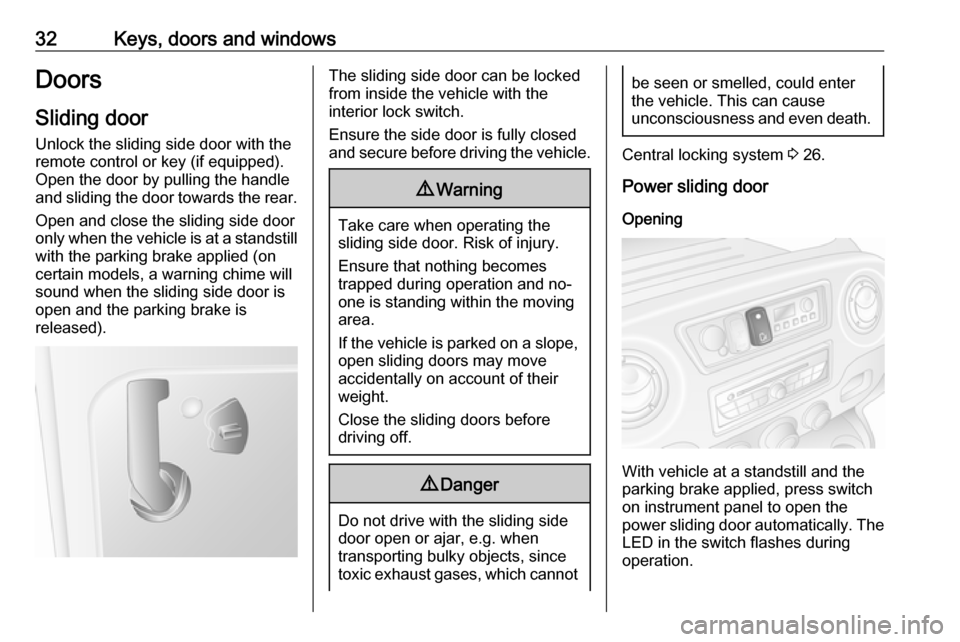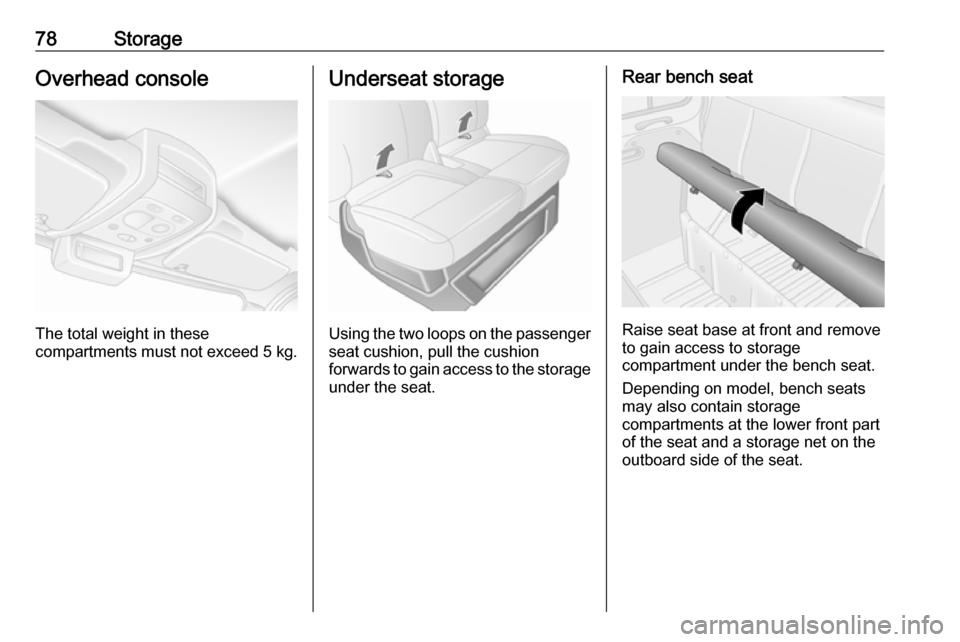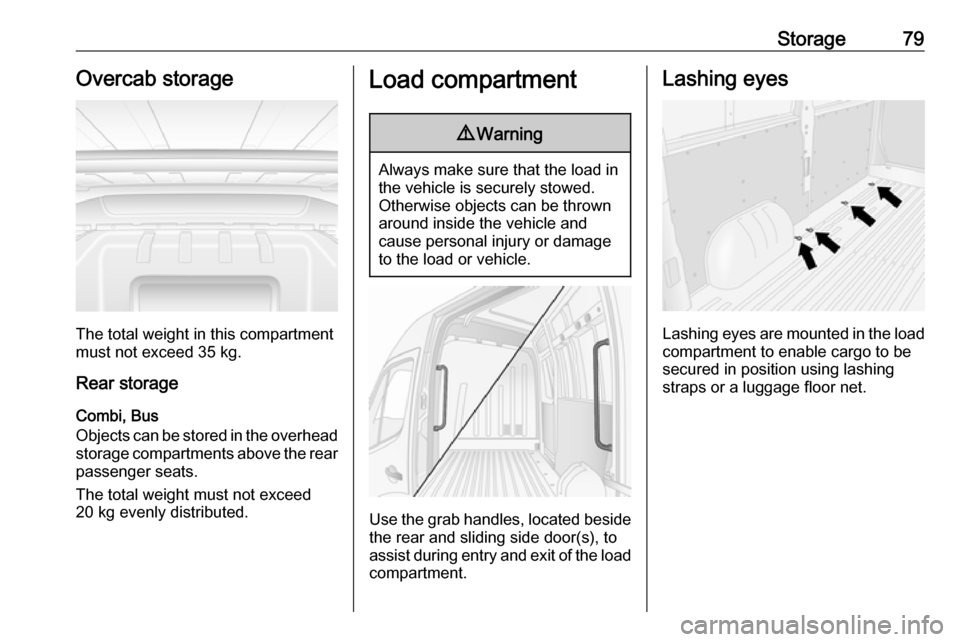weight OPEL MOVANO_B 2018.5 Manual user
[x] Cancel search | Manufacturer: OPEL, Model Year: 2018.5, Model line: MOVANO_B, Model: OPEL MOVANO_B 2018.5Pages: 271, PDF Size: 6.5 MB
Page 34 of 271

32Keys, doors and windowsDoors
Sliding door
Unlock the sliding side door with the remote control or key (if equipped).
Open the door by pulling the handle
and sliding the door towards the rear.
Open and close the sliding side door
only when the vehicle is at a standstill with the parking brake applied (on
certain models, a warning chime will
sound when the sliding side door is
open and the parking brake is
released).The sliding side door can be locked
from inside the vehicle with the
interior lock switch.
Ensure the side door is fully closed
and secure before driving the vehicle.9 Warning
Take care when operating the
sliding side door. Risk of injury.
Ensure that nothing becomes
trapped during operation and no-
one is standing within the moving
area.
If the vehicle is parked on a slope,
open sliding doors may move
accidentally on account of their
weight.
Close the sliding doors before
driving off.
9 Danger
Do not drive with the sliding side
door open or ajar, e.g. when
transporting bulky objects, since
toxic exhaust gases, which cannot
be seen or smelled, could enter
the vehicle. This can cause
unconsciousness and even death.
Central locking system 3 26.
Power sliding door
Opening
With vehicle at a standstill and the
parking brake applied, press switch
on instrument panel to open the
power sliding door automatically. The
LED in the switch flashes during
operation.
Page 72 of 271

70Seats, restraintsChild restraint installation locations
Permissible options for fitting a child restraint system Front seats - All variantsWeight and age classSingle seat - front passenger side 1)Bench seat - front passenger sidewithout airbagwith airbagwithout airbagwith airbagcentreoutercentreouterGroup 0: up to 10 kg
Group 0+: up to 13 kgUU 2)UUU 2)U2)Group I: 9 to 18 kgUU 2)UUU2)U 2)Group II: 15 to 25 kg
Group III: 22 to 36 kgUU 2)UUU 2)U2)1)
If adjustable, ensure seat is in its rearmost position. Make sure vehicle seat belt is as straight as possible between shoulder and
upper anchorage point.
2) Ensure the front passenger airbag system is deactivated when installing a child restraint in this position.
Page 73 of 271

Seats, restraints71Crew van - rear seatsWeight and age class2nd row seatsOuterCentreGroup 0: up to 10 kg
Group 0+: up to 13 kgUXGroup I: 9 to 18 kgUXGroup II: 15 to 25 kg
Group III: 22 to 36 kgUX
Page 74 of 271

72Seats, restraintsCombi - rear seatsWeight and age class2nd row seats3rd row seatsDriver side
outer seat
Centre seat
Passenger side
outer seatGroup 0: up to 10 kg
Group 0+: up to 13 kgU 3)
,
Move the front seat as far forward as possible to install a rear facing child seat, then move back the seat in front in accordance with
the child seat instructions.
4) Forward facing child seat; position the seatback of the child seat in contact with the seatback of the vehicle seat. Adjust the height
of the headrest or remove it if necessary; do not push the seat in front of the child more than halfway back on its runners and do not recline the seatback more than 25°.
Bus - rear seats
Weight and age classRear seatsGroup 0: up to 10 kg
Group 0+: up to 13 kgXGroup I: 9 to 18 kgXGroup II: 15 to 25 kg
Group III: 22 to 36 kgX
Page 75 of 271

Seats, restraints73Crew cab - rear seatsWeight and age class2nd row seatsOuterCentreGroup 0: up to 10 kg
Group 0+: up to 13 kgUXGroup I: 9 to 18 kgUXGroup II: 15 to 25 kg
Group III: 22 to 36 kgUXU:suitable for universal category restraint systems for use in this weight and age class, in conjunction with three-point
seat belt.UF:suitable for universal category forward-facing restraint systems for use in this weight and age class, in conjunction
with three-point seat belt.<:suitable for ISOFIX child restraint system with mounting brackets and anchorage points, where fitted. When mounting
an ISOFIX child restraint system, only systems that have been approved for the vehicle may be used. Refer to
" Permissible options for fitting an ISOFIX child restraint system ".X:seat position not suitable for children in this weight and age class.
Page 76 of 271

74Seats, restraintsPermissible options for fitting an ISOFIX child restraint systemCombiWeight classSize classFixtureFront seats2nd row seats3rd row seatsDriver side
outer seat
Centre seat
Passenger side
outer seatGroup 0: up to 10 kgEISO/R1XILXXXGroup 0+: up to 13 kgEISO/R1XILXXXDISO/R2XILXXXCISO/R3XILXXXGroup I: 9 to 18 kgDISO/R2XILXXXCISO/R3XILXXXBISO/F2XIL, IUFIL, IUFXXB1ISO/F2XXIL, IUFIL, IUFXXAISO/F3XIL, IUFIL, IUFXXIL:suitable for particular ISOFIX restraint systems of the "specific-vehicle", "restricted" or "semi-universal" categories.
The ISOFIX restraint system must be approved for the specific vehicle type.IUF:suitable for ISOFIX forward-facing child restraint systems of universal category approved for use in this weight class.X:no ISOFIX child restraint system approved in this weight class.
Page 77 of 271

Seats, restraints75ISOFIX size class and seat deviceA - ISO/F3:forward-facing child restraint system for children of maximum size in the weight class 9 to 18 kg.B - ISO/F2:forward-facing child restraint system for smaller children in the weight class 9 to 18 kg.B1 - ISO/F2X:forward-facing child restraint system for smaller children in the weight class 9 to 18 kg.C - ISO/R3:rear-facing child restraint system for children of maximum size in the weight class up to 18 kg.D - ISO/R2:rear-facing child restraint system for smaller children in the weight class up to 18 kg.E - ISO/R1:rear-facing child restraint system for young children in the weight class up to 13 kg.
Page 80 of 271

78StorageOverhead console
The total weight in these
compartments must not exceed 5 kg.
Underseat storage
Using the two loops on the passenger
seat cushion, pull the cushion
forwards to gain access to the storage
under the seat.
Rear bench seat
Raise seat base at front and remove
to gain access to storage
compartment under the bench seat.
Depending on model, bench seats
may also contain storage
compartments at the lower front part
of the seat and a storage net on the
outboard side of the seat.
Page 81 of 271

Storage79Overcab storage
The total weight in this compartment
must not exceed 35 kg.
Rear storage
Combi, Bus
Objects can be stored in the overhead
storage compartments above the rear passenger seats.
The total weight must not exceed
20 kg evenly distributed.
Load compartment9 Warning
Always make sure that the load in
the vehicle is securely stowed.
Otherwise objects can be thrown
around inside the vehicle and
cause personal injury or damage
to the load or vehicle.
Use the grab handles, located beside
the rear and sliding side door(s), to
assist during entry and exit of the load compartment.
Lashing eyes
Lashing eyes are mounted in the load
compartment to enable cargo to be secured in position using lashing
straps or a luggage floor net.
Page 87 of 271

Storage85Roof rack system
Roof rack For safety reasons and to avoiddamage to the roof, the vehicle
approved roof rack system is
recommended.
Follow the installation instructions
and remove the roof rack when not in
use.Loading information
● Heavy objects in the load compartment should be evenlydistributed and placed as far
forward as possible. If objects
can be stacked, the heavier
objects should be placed at the
bottom.
● Secure objects with lashing straps attached to lashing eyes
3 79.
● Secure objects into position or prevent loads from sliding
excessively by attaching optional cargo management features to
the load rails using removable
lashing eyes.
Cargo management system
3 80.
● Secure loose objects in load compartment to prevent them
from sliding.
● The load must not obstruct the operation of the pedals, parking
brake and gear selector lever, orhinder the freedom of movement of the driver. Do not place any
unsecured objects in the interior.
● Do not drive with an open load compartment. In addition, the
number plate is only
distinguishable and illuminated correctly if the doors are closed.9 Warning
Always make sure that the load in
the vehicle is securely stowed.
Otherwise objects can be thrown
around inside the vehicle and
cause personal injury or damage
to the load or vehicle.
● The payload is the difference between the permitted gross
vehicle weight (see identification
plate 3 231) and the EC kerb
weight.
To calculate the payload, enter
the data for your vehicle in the
Weights table at the front of this
manual.
The EC kerb weight includes
weights for the driver (68 kg),